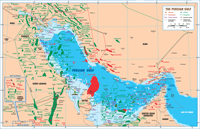|
Aug.
2001 Vol. 222 No. 8
International Outlook
|
MIDDLE EAST
Dr. A. F. Alhajji, Contributing Editor,
Boulder, Colorado
Others
Bahrain. Higher oil prices led to 4.5% economic
growth in 2000, and that rate should continue this year. Demarcation of maritime borders with Qatar brought
relief to oil-exhausted Bahrain. Immediately after the International Court of Justice announced its decision
that awarded Hawar Island to Bahrain in March, the country created four new exploration blocks. Bahrain also
gained part of Qatar’s Block 13, which is under an EPSA and held by BP, Gulf Stream Resources and
Preussag. The block had been under force majeure because of the border dispute.
Drilling fell 17%, to 25 wells, all of them oil
producers. Footage drilled was 69,023, down 24%. Bahrain’s crude output increased slightly, to 37,581
bpd. Most of the oil is produced onshore from Awali field. Active oil wells increased to 435 from 419.
The country also shares the Abu Safah offshore field
50/50 with Saudi Arabia. However, Saudi has allowed Bahrain to receive all the production proceeds since 1996
– last year’s output was 143,164 bopd. Natural gas production declined 1.5% last year, to 866 MMcfd.
Producing gas wells totaled 33, versus 34 in 1999.
Jordan. The main problem is not a lack of
hydrocarbons; it is a scarcity of water. Limited freshwater supplies hinder economic growth and development.
New membership in WTO, privatization measures, and opening the economy to foreign investment led to 3.2%
economic growth in 2000, versus 1.6% in 1999. That rate should continue this year.
New investment laws sparked interest in Jordan’s
seven exploration blocks. New terms include PSAs that allow (with output of more than 200,000 bopd) 70% of
output to go to recouping company costs, with 30% divided equally with the government. The percentage that the
company can recoup is based on a sliding scale when production is less than 200,000 bopd.
Last October, Canada’s Dauntless signed for the
Jafer area in the south. Britain’s Star Petroleum and Australia’s Black Rock Petroleum signed a JV,
to explore the North Highland Block in the northern region.
Plans for Risha gas field call for doubling production
this year, to 60 MMcfgd, through horizontal drilling and hydraulic fracturing. As of July 2000, nine companies
had bid to develop this field. Nationwide, gas production stood at 30 MMcfgd, and gas reserves were estimated
at 220 Bcf.
Gaza / West Bank. Last October, BG
International said that it would reapply for a security clearance, to drill a second exploration well in its
Gaza concession. The firm had lost its clearance, which is issued by Israel, after area violence erupted. BG
started drilling the second well, Marine 2, despite the violence. BG’s 25-year deal with the Palestinian
Authority commits the firm to drill two offshore wells. Last September, the company struck gas in Marine 1, at
37 MMcfd. Reserves are estimated at 2 Tcf.
Israel. Violence and the threat of war took
their toll on the Israeli economy, which had been set for solid growth because of economic reforms. Energy
remains under governmental control.
Several companies discovered relatively significant
amounts of gas offshore. In August 2000, Isramco found a large gas field in its Nir 1 well, drilled in 653 ft
(199 m) of water and tested at 15 MMcfgd. Estimated field reserves are 274 Bcfg. This is the third gas field
discovered offshore.
In May, Yam Thetis indicated it would invest $235
million to build a gas production / distribution system from Mari field to the coast. Ness Energy
International and Labidoth Israel Oil Prospectors Corp. agreed last September to develop the Har Sedom 1 find.
Israel’s National Infrastructure Ministry canceled Givat Olam’s Rosh Haayan drilling license last
December.
According to the Ministry of Infrastructure, wells
drilled doubled in 2000, to eight (four gas wells and four dry holes). In 2000, there were 56,938 ft drilled,
up 82.7%. Five onshore and three offshore wells are expected this year. In 2000, there were five producing oil
wells, all on artificial lift. In addition, 14 gas wells were capable of producing, of which six were active.
Production stood at 69 bopd and 938,000 cfgd. Oil reserves dropped 1%, to 3.84 million bbl, while gas reserves
jumped 272%, to 1.75 Tcf.
UAE – Sharjah. This emirate is keen to
develop its gas resources, to meet domestic demand and for exports to Dubai. Further gas discoveries may
qualify this growing emirate to participate in the Dolphin project and supply gas to other countries.
Late last year, Crescent Petroleum found major gas
reserves offshore Sharjah. The Sharjah 2 flowed 19 MMcfgd and 150 bcpd. Reserves are estimated at 500 Bcf of
gas. Amoco Sharjah Oil Co. initiated gas output from two wells at the end of 2000. Drilled by Santa Fe
International, they are producing 40 MMcfgd, each.
UAE – Umm al Quwain. Norway’s
Atlantis Holding Co. signed a concession deal in April 2000 to explore 344 sq mi (890 sq km). The company was
obligated to shoot 309 sq mi of 3-D seismic and drill one pilot well. By this time, the company should have
completed testing Umm Al-Quwain 3, an offshore exploratory well. Based on the findings, the company may drill
three to five wells at a cost of $15 million, each. The offshore gas field is estimated to contain up to 500
Bcf of gas and a small quantity of condensate. Atlantis plans to begin production in fourth-quarter 2002, at
100 MMcfgd, for power generation and other industrial purposes.

|



